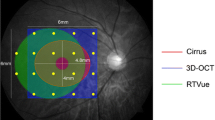Abstract
To evaluate eyes with abnormal visual fields and multifocal electroretinograms (mfERGs) but normal-appearing frequency-domain optical coherence tomography (fdOCT) scans, the thicknesses of the outer retinal layers were measured. A total of 25 eyes from 17 patients, including 15 eyes previously tested (Dale et al. in Doc Ophthalmol 120(2):175–186, 2009) were examined. All patients were evaluated with standard automated perimetry (SAP) using the 24-2 and/or 10-2 program (Zeiss Meditec), mfERG with 103 hexagons (Veris, EDI), and fdOCT imaging (3DOCT-2000, Topcon) with scans of the macula. All patients had reliable visual fields showing macular defects and good quality mfERG and fdOCT results. The mfERG results were classified as abnormal based on decreased amplitudes and/or increased latencies corresponding to the abnormal visual field. Based on visual inspection, three experienced observers classified the fdOCT scans as normal or inconclusive, as opposed to clearly abnormal. Retinal layers of the fdOCT scans were manually segmented with the aid of a computer program and compared to mean thicknesses from 20 controls. The thicknesses of the outer segment plus retinal pigment epithelium, total receptor, and inner nuclear layers were measured. Quantitative analysis of fdOCT scans demonstrated thinning of the outer retina in some scans that was not readily apparent on visual inspection. One or more of the outer retinal layers was significantly thinner in 15 of the 25 eyes. The absence of significant thinning in the other 10 eyes represents instances in which functional loss measured by visual fields and mfERGs can precede clear structural changes on fdOCT.




Similar content being viewed by others
Abbreviations
- mfERG:
-
Multifocal electroretinogram
- fdOCT:
-
Frequency-domain optical coherence tomography
- SAP:
-
Standard automated perimetry
References
Ko TH, Fujimoto JG, Schuman JS, Paunescu LA, Kowalevicz AM, Hartl I, Drexler W, Wollstein G, Ishikawa H, Duker JS (2005) Comparison of ultrahigh- and standard-resolution optical coherence tomography for imaging macular pathology. Ophthalmology 112(11):1922.e1–1922.e15
Rangaswamy NV, Patel HM, Locke KG, Hood DC, Birch DG (2010) A comparison of visual field sensitivity to photoreceptor thickness in retinitis pigmentosa. Invest Ophthalmol Vis Sci 51(8):4213–4219
Hood DC, Ramachandran R, Holopigian K, Lazow M, Birch DG, Greenstein VC (2011) Method for deriving visual field boundaries from OCT scans of patients with retinitis pigmentosa. Biomed Opt Express 2(5):1106–1114
Dale EA, Hood DC, Greenstein VC, Odel JG (2009) A comparison of multifocal ERG and frequency domain OCT changes in patients with abnormalities of the retina. Doc Ophthalmol 120(2):175–186
Kellner S, Weinitz S, Kellner U (2009) Spectral domain optical coherence tomography detects early stages of chloroquine retinopathy similar to multifocal electroretinography, fundus autofluorescence and near-infrared autofluorescence. Br J Ophthalmol 93(11):1444–1447
Kellner U, Kellner S, Weinitz S (2008) Chloroquine retinopathy: lipofuscin- and melanin-related fundus autofluorescence, optical coherence tomography and multifocal electroretinography. Doc Ophthalmol 116(2):119–127
Jacobson SG, Aleman TS, Cideciyan AV, Roman AJ, Sumaroka A, Windsor EA, Schwartz SB, Heon E, Stone EM (2009) Defining the residual vision in leber congenital amaurosis caused by RPE65 mutations. Invest Ophthalmol Vis Sci 50(5):2368–2375
Ohta K, Sato A, Fukui E (2009) Spectral domain optical coherence tomographic findings at convalescent stage of acute zonal occult outer retinopathy. Clin Ophthalmol 3:423–428
Sutter EE, Tran D (1992) The field topography of ERG components in man—I. The photopic luminance response. Vis Res 32(3):433–446
Hood DC (2000) Assessing retinal function with the multifocal technique. Prog Retin Eye Res 19(5):607–646
Hood DC, Frishman LJ, Saszik S, Viswanathan S (2002) Retinal origins of the primate multifocal ERG: implications for the human response. Invest Ophthalmol Vis Sci 43(5):1673–1685
Hood DC, Lin CE, Lazow MA, Locke KG, Zhang X, Birch DG (2009) Thickness of receptor and post-receptor retinal layers in patients with retinitis pigmentosa measured with frequency-domain optical coherence tomography. Invest Ophthalmol Vis Sci 50(5):2328–2336
Hood DC, Lazow MA, Locke KG, Greenstein VC, Birch DG (2011) The transition zone between healthy and diseased retina in patients with retinitis pigmentosa. Invest Ophthalmol Vis Sci 52(1):101–108
Hood DC, Bach M, Brigell M, Keating D, Kondo M, Lyons JS, Palmowski-Wolfe AM (2008) ISCEV guidelines for clinical multifocal electroretinography (2007 edition). Doc Ophthalmol 116(1):1–11
Hood DC, Cho J, Raza AS, Dale EA, Wang M (2011) Reliability of a computer-aided manual procedure for segmenting optical coherence tomography scans. Optom Vis Sci 88(1):113–123
Birch DG, Wen Y, Locke KG, Hood DC (2011) Rod sensitivity, cone sensitivity and photoreceptor layer thickness in retinal degenerative disease. Invest Ophthalmol Vis Sci. PMID: 21810977
Acknowledgements
We thank Drs. M. Behrens, S. Kane, J. Bortz, S. Forman, and R. Lesser for referring patients. This work was supported by a Doris Duke Charitable Foundation grant to CLT and a NIH grant R01-09076 to DCH.
Conflict of interest
None.
Author information
Authors and Affiliations
Corresponding author
Rights and permissions
About this article
Cite this article
Talamini, C.L., Raza, A.S., Dale, E.A. et al. Abnormal multifocal ERG findings in patients with normal-appearing retinal anatomy. Doc Ophthalmol 123, 187–192 (2011). https://doi.org/10.1007/s10633-011-9297-7
Received:
Accepted:
Published:
Issue Date:
DOI: https://doi.org/10.1007/s10633-011-9297-7




